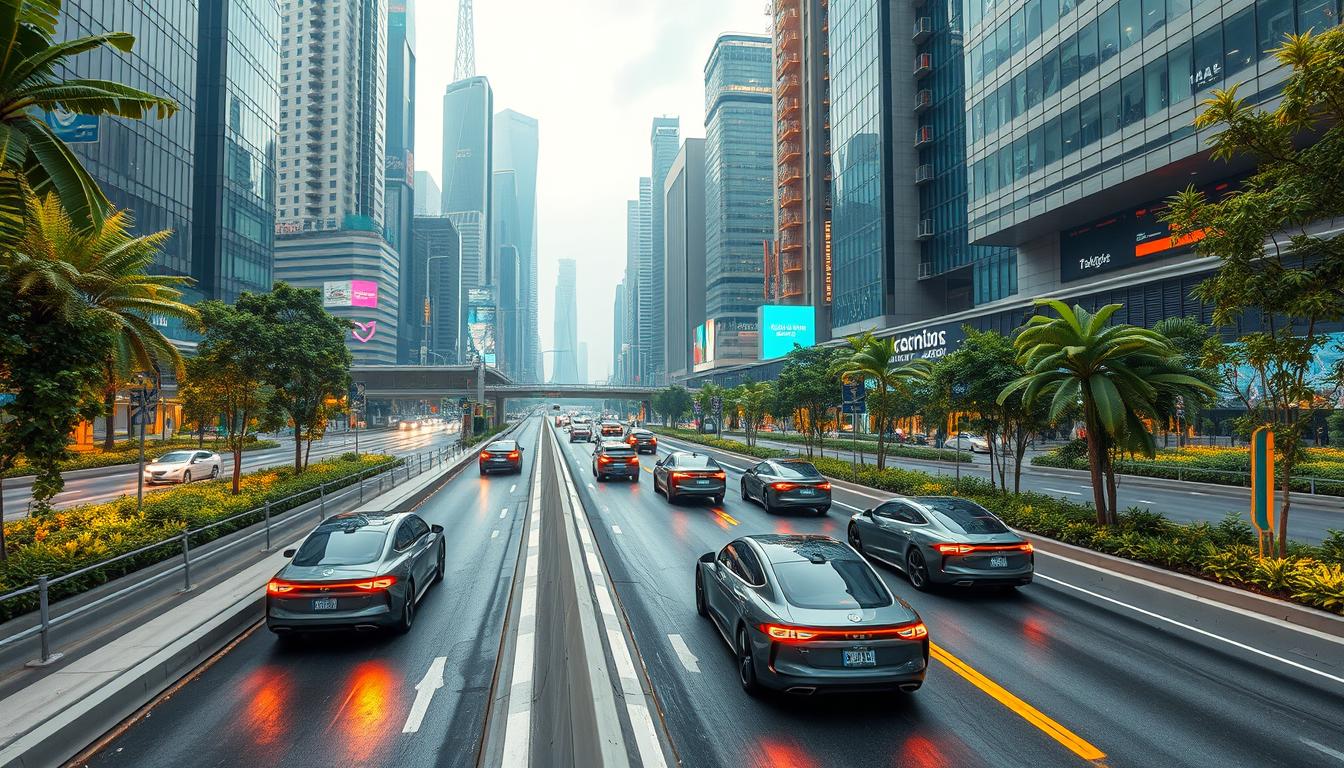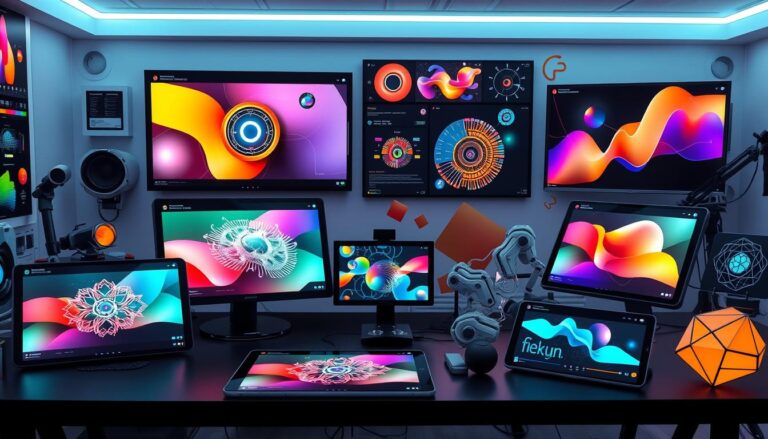Did you know that about 94% of U.S. car accidents are caused by human mistakes? This shows a huge chance for better safety with self-driving cars1. The move to self-driving vehicles is changing how we travel, thanks to AI. Big companies are putting a lot of money into making these cars a reality.
Even with some delays, like not seeing fully self-driving cars until 2035, the impact is huge2. By 2040, about 25% of cars worldwide could be self-driving1. The World Economic Forum says these cars could bring in $67 billion and save $3.1 trillion, changing how we travel and live1.
This part shows how AI is key for making self-driving cars better. It makes them safer, more efficient, and better for the planet. To learn more, check out this in-depth article.
Key Takeaways
- AI is rapidly transforming the transportation landscape.
- 94% of vehicular accidents are due to human error, highlighting the potential for autonomous vehicles to enhance safety.
- The integration of AI can significantly boost the economic value and societal benefits of transportation solutions.
- Fully autonomous vehicles may not be available until 2035, indicating a gradual transition.
- Investments and innovations in AI technology continue to support the development of self-driving cars.
Introduction to AI in Transportation
The use of AI in transportation is changing how we see moving around. Terms like autonomous vehicles, machine learning, and advanced driver-assistance systems (ADAS) are key. These technologies let cars drive on their own, a big change from how we drive now.
The DARPA Grand Challenge from 2004 to 2007 was a big moment. It showed how far self-driving cars had come and how ready they were for real use3.
Definition of key terms
Self-driving technology means cars can move without a person controlling them. It includes everything from semi-automated features to cars that can drive all by themselves. The Society of Automotive Engineers (SAE) has defined six levels of self-driving cars3.
AI in transportation uses many methods and technologies. These help cars do complex driving tasks.
Importance of AI in modern transport
AI is crucial for making transport safer, more efficient, and green. Most accidents are caused by human mistakes. Self-driving cars could greatly lower these numbers3.
They also make traffic flow better by letting cars drive close together at the same speed4. Plus, they help people who can’t drive, like the elderly and those with disabilities4.
The big changes in logistics and mobility will shape the future of city transport.
Overview of Autonomous Vehicles
The world of autonomous vehicles is changing fast, thanks to AI in transportation. These cars are divided into levels, from 0 (no automation) to 5 (fully autonomous)5. Most cars today have Level 2 automation, with features like GM’s Super Cruise and Tesla’s Full Self-Driving5.
Types of autonomous vehicles
There are many types of autonomous vehicles, each with its own role. Here are a few:
- Personal vehicles: Made for personal use, these cars offer a smooth ride without needing you to drive.
- Commercial trucks: These trucks are for moving goods, making delivery faster and more efficient.
- Shared transportation: Roaming taxis are becoming popular, offering quick rides that could change city travel.
Current market leaders
The race for autonomous vehicles is fierce, with leaders like Waymo and Tesla at the front. Waymo has driven 20 million miles on public roads, showing their dedication to safety6. Tesla has also made big strides, with its Autopilot system logging 3 billion miles, showing strong user support6.
Experts predict the U.S. market for these vehicles will hit $78.63 billion by 20306. With new tech and growing demand, the future looks bright for this field.
Key Technologies Behind Self-Driving Cars
Self-driving cars rely on many new technologies. These improve how they work and keep us safe. Knowing about these is key to understanding the future of cars.
Machine learning and AI algorithms
Machine learning is very important for self-driving cars. It lets them learn from what’s around them. Tesla’s Autopilot, started in 2016, shows how it helps cars drive on highways7.
Sensor technologies and data processing
Sensors are vital for self-driving cars to see and understand their world. Radar, lidar, and cameras help them navigate safely. Google’s self-driving car project, for example, drove over a million miles by 20157. Also, the need for secure data processing is growing fast8.
Connectivity and communication systems
Good connectivity is essential for self-driving cars to work better. V2X communication helps cars talk to each other and the road. With 5G coming, these systems will get even better, meeting our needs for smarter cars8.
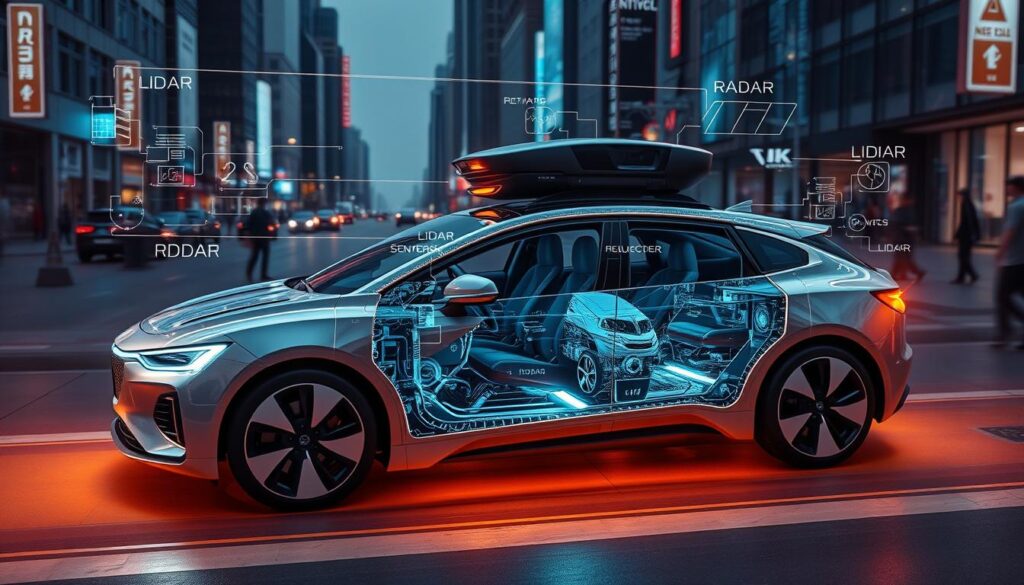
Safety and Regulations in Autonomous Driving
Ensuring the safety of self-driving cars is crucial. This is influenced by government rules and standards. These rules make sure self-driving tech follows safety rules when tested and used on roads.
Government regulations and standards
Government rules set safety standards for self-driving cars. In 2022, the U.S. saw 42,795 traffic deaths, mostly due to human mistakes. This shows why strict rules for self-driving cars are key to reducing accidents.
Safety enhancements and testing protocols
Improving safety is key for self-driving tech. Features like automated braking and ADAS systems help prevent accidents9. Tests show self-driving cars could be safer than human-driven ones9.
| Safety Aspect | Statistics | Impact on Regulations |
|---|---|---|
| Traffic Fatalities (2022) | 42,795 | Increased scrutiny on government regulations |
| Human Error in Accidents | 94% | Emphasis on automated safety technologies |
| Potential Reduction in Fatalities | 30% reduction in drunk driving-related fatalities | Encouragement for further technological advancements |
Automated fleets use GPS and AI cameras for safety. These systems boost safety and efficiency in transport9. They show how self-driving tech improves our daily lives.
Impact of Autonomous Vehicles on Society
Autonomous vehicles are changing how we move around, making it easier for the elderly and disabled. As we move towards smart mobility, we see how these vehicles are reshaping our society.
Changes in transportation accessibility
Self-driving cars are making cities more accessible. Studies show they might make more people use public transit10. This could lead to more people visiting places they couldn’t before, boosting social connections.
Effects on urban planning and infrastructure
As cities get autonomous vehicles, they’ll need to change their plans. They might create special lanes and parking for these cars11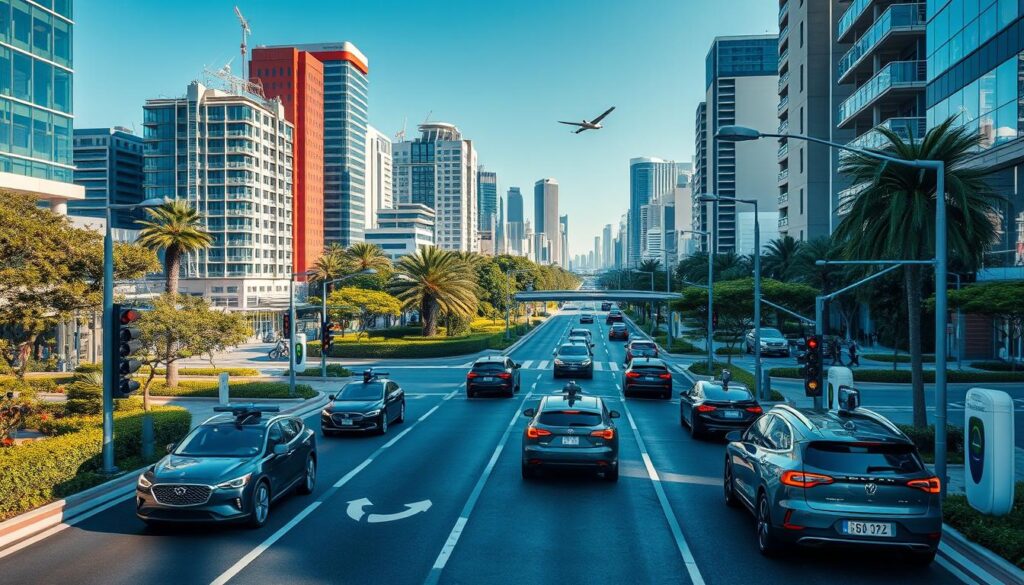
| Aspect | Impact of Autonomous Vehicles | Urban Planning Considerations |
|---|---|---|
| Transportation Accessibility | Increased access for individuals with mobility challenges | New routes and services may emerge to accommodate demand |
| Urban Sprawl | Potential population shifts towards urban centers | Required adjustment in zoning laws and infrastructure |
| Car Ownership Trends | Shift towards car-sharing models | Rethinking of parking and garage requirements |
The future of travel will be shaped by autonomous vehicles. Urban planners must find new ways to benefit from them while solving problems.
For a deeper understanding of the implications of autonomous vehicles on society, refer to this comprehensive study10
Economic Implications of Self-Driving Technology
The arrival of self-driving cars changes the job market and business world. It’s important to watch these changes. They will shape future jobs and challenges.
Job displacement concerns
Self-driving cars will disrupt some jobs. Jobs like truck drivers, taxi drivers, and delivery drivers might disappear. This could lead to a lot of job losses in driving roles12.
By 2040-2050, cities will see most of the use of self-driving cars. This could make job loss worse13. But, it will also open up new job areas like IT and vehicle services12.
New job opportunities in the tech sector
Self-driving tech also means new jobs. The market for self-driving cars is growing fast, from $33.5 billion in 2023 to over $93 billion by 202812. Jobs in computer science and vehicle engineering will be key as companies adapt13.
The U.S. economy could see big gains, up to $936 billion a year. This could also create 2.4 million new jobs and increase people’s earnings14. This change is not just about making things easier. It’s a big economic shift for many sectors.
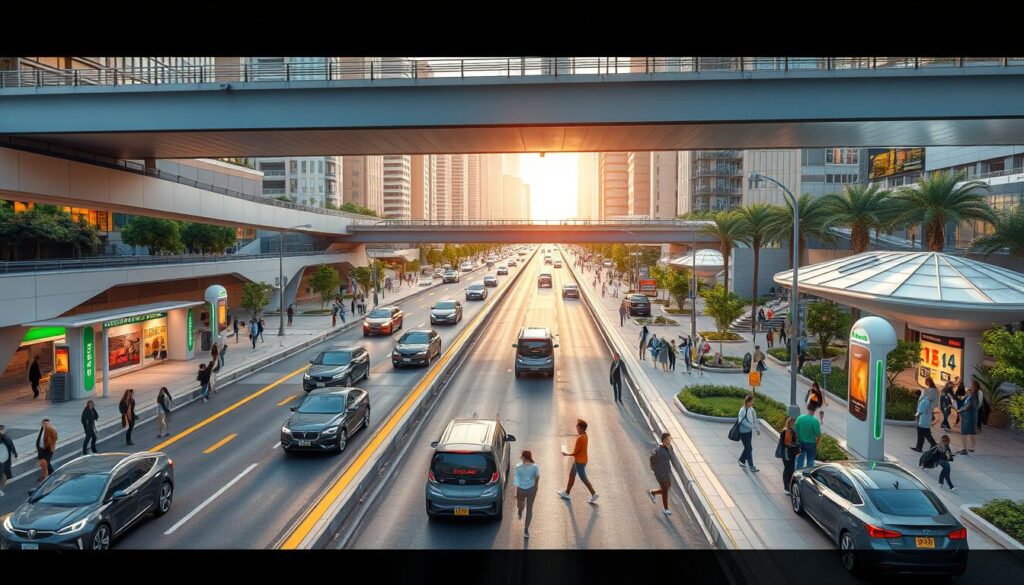
| Aspect | Job Displacement | New Job Opportunities |
|---|---|---|
| Impact on Drivers | Reduction in traditional roles like bus and taxi drivers | Increase in IT and technical jobs |
| Market Size | Not applicable | $33.5 billion in 2023, growing to over $93 billion by 2028 |
| Potential Gains | Challenges in workforce integration | Estimated gains of $936 billion yearly in the U.S. |
Challenges Facing Self-Driving Technology
Self-driving vehicles face big challenges before they can be widely used. Technical limitations are a major issue. These include problems with sensors in bad weather and handling unpredictable human actions. Fixing these problems is key to making self-driving cars safe.
Technical limitations and hurdles
Self-driving tech often has trouble seeing things clearly in different weather. For example, sensors might not tell the difference between real and fake obstacles. Also, self-driving cars sometimes see things that aren’t there, which can cause accidents15. This shows we need better AI and learning machines to make self-driving cars reliable.
Public perception and acceptance
Getting people to trust self-driving cars is hard. There are worries about safety, ethics, and job loss. Knowing that most accidents are caused by humans might help show the benefits of self-driving cars15. But, fears about job loss and more traffic in cities like Seattle make it harder16.
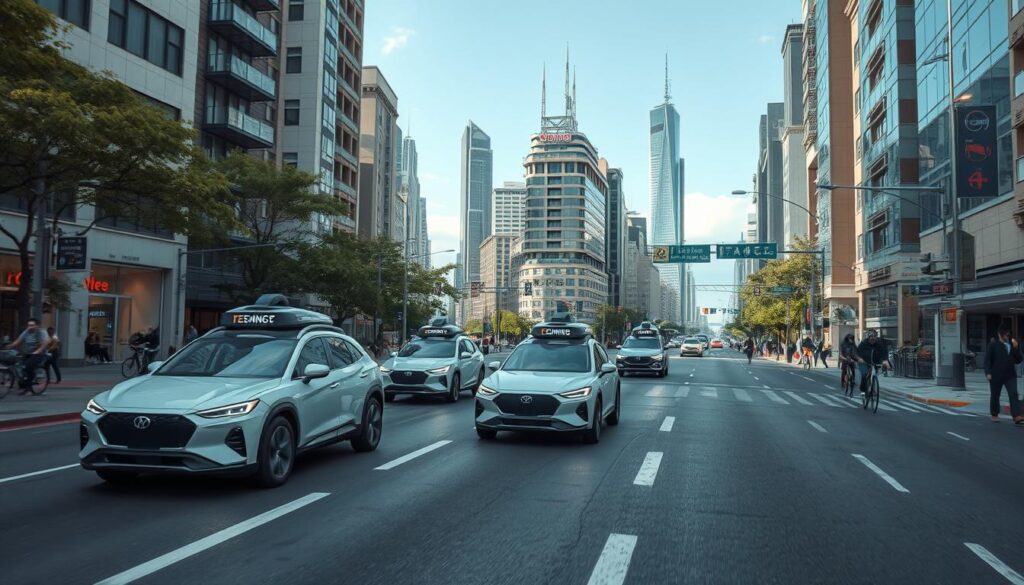
To win people over, we need to make sure self-driving cars are secure and teach emergency services how to handle them. This will help calm fears and make people more open to self-driving cars.
In short, to solve the challenges of autonomous vehicles, we must tackle both technical limitations and public trust. We need specific plans to make self-driving cars safe, accessible, and trusted by everyone16.
Future Trends in Autonomous Vehicles
Technology is moving fast, changing how we see autonomous vehicles. Soon, we’ll see big improvements in these cars. The AI in transportation market is expected to hit $10.3 billion by 2030, showing how much people want new tech17. Better sensors will make these cars safer and more accurate18.
Innovations on the horizon
New mapping tech will make detailed 3D maps and update them in real-time. This will help self-driving cars navigate better18. Testing will get faster with advanced tools, making these cars safer for everyone18.
As these cars use electric power, they’ll use less fossil fuel. This makes them better for our planet18.
Integration with smart city technologies
Smart city tech is key for self-driving cars to work well in cities. Places like Dubai are testing new ideas, like smart plates for cars. These connect cars to services and systems17.
This tech will make cities safer and more efficient. It could cut down on road deaths, which are a big problem worldwide19.
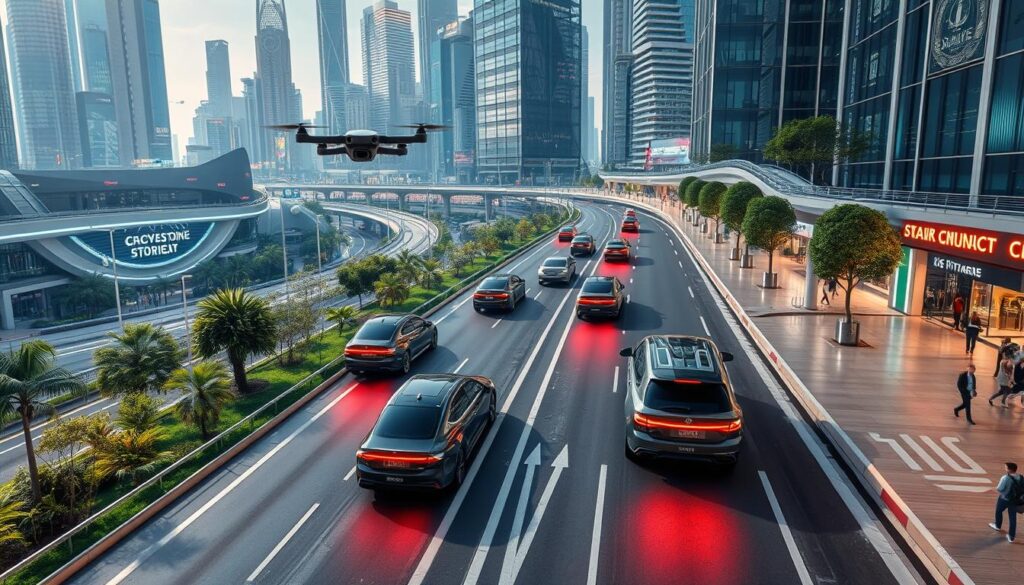
By using these new trends, cities can make traffic better and save time. This could cut down on wasted time in traffic by up to 90%19. New ways to get around will also help the environment and use resources better18.
As we move forward, working together on tech and city planning is crucial18.
Conclusion: The Road Ahead for AI and Transportation
Looking back, AI in transportation has made huge strides. Companies like Tesla, Waymo, and Cruise are leading the way. They use AI to make cars smarter, analyzing data from sensors and cameras20.
The journey started in the 1950s. It has grown a lot, with Google’s self-driving car project being a big step in 200921. Now, cars can see their surroundings thanks to LiDAR and radar.
The future of self-driving cars is exciting. They could make roads safer and find the best routes. But, there are still challenges like rules and how people feel about AI making big decisions2021.
Everyone needs to work together to make this technology safe and trusted. This will help people feel okay with using it.
For self-driving cars to be part of our daily lives, we need to keep talking and thinking creatively. We must also focus on using AI in a way that’s fair and right. This will change how we move around, making it better for everyone. You can read more about this in this article that goes into detail20.
FAQ
What are autonomous vehicles (AVs)?
How does AI improve transportation safety?
What are the different levels of automation in self-driving cars?
Which companies are leading in self-driving technology?
What technologies are crucial for the functioning of autonomous vehicles?
How are governments regulating the deployment of autonomous vehicles?
What impact will autonomous vehicles have on urban planning?
Will self-driving technology lead to job loss?
What challenges must be overcome for widespread adoption of autonomous vehicles?
What future trends are emerging in the autonomous vehicle sector?
Source Links
- Securing the future of driverless cars – https://www.brookings.edu/articles/securing-the-future-of-driverless-cars/
- Leveling up AI: how close are we to self-driving cars? – https://www.here.com/learn/blog/ai-how-close-are-we-to-self-driving-cars
- AI in Transportation: Self-Driving Cars – https://www.linkedin.com/pulse/ai-transportation-self-driving-cars-ai-news-3ycwe
- Exploring the Role of AI in Self-Driving Cars – https://www.appventurez.com/blog/ai-in-self-driving-cars
- What Are Self-Driving Cars? The Technology Explained – https://www.forbes.com/sites/technology/article/self-driving-cars/
- Autonomous Vehicles Factsheet – https://css.umich.edu/publications/factsheets/mobility/autonomous-vehicles-factsheet
- AI in Self-Driving Cars: Key Technologies Explained – https://redresscompliance.com/ai-in-self-driving-cars/
- Self-driving cars take the wheel – https://www.technologyreview.com/2019/02/15/137381/self-driving-cars-take-the-wheel/
- Autonomous Vehicle Safety: The Future of Driving | SafetyCulture – https://safetyculture.com/topics/autonomous-vehicle-safety/
- Autonomous vehicles as a “killer app” for AI – https://www.brookings.edu/articles/autonomous-vehicles-as-a-killer-app-for-ai/
- Impact of self-driving cars on society – https://www.bosch.com/stories/impact-of-self-driving-cars-on-society/
- How Self-Driving Cars Could Change the Auto Industry – https://www.investopedia.com/articles/personal-finance/031315/selfdriving-cars-could-change-auto-industry.asp
- Economic impact of self-driving cars – https://www.bosch.com/stories/economic-impact-of-self-driving-cars/
- What might be the economic implications of autonomous vehicles? – Economics Observatory – https://www.economicsobservatory.com/what-might-be-the-economic-implications-of-autonomous-vehicles
- Potential Problems with Self-Driving Cars – https://williammattar.com/practice-areas/self-driving-car-accident-attorney/potential-problems-with-self-driving-cars/
- The 6 Challenges of Autonomous Vehicles and How to Overcome Them – https://www.govtech.com/fs/The-6-Challenges-of-Autonomous-Vehicles-and-How-to-Overcome-Them.html
- Blog | AI IN TRANSPORTATION: THE FUTURE OF TRANSPORT | World AI Cannes Festival 2025 – https://www.worldaicannes.com/en-gb/resources/blog/ai-in-transportation-the-future-of-transport.html
- Emerging Trends in Autonomous Vehicles and their Impact on the Future of Transportation – https://datafloq.com/read/etrends-autonomous-vehicles-impact-future-transportation/
- The Future of Autonomous Vehicles — Futures Platform – https://www.futuresplatform.com/blog/future-autonomous-vehicles
- undefined – https://indiaai.gov.in/article/the-road-ahead-exploring-ai-s-impact-on-autonomous-vehicles-and-transportation
- AI and Transportation: The Future of Work in Motion – https://www.refer.me/blog/ai-and-transportation-the-future-of-work-in-motion
